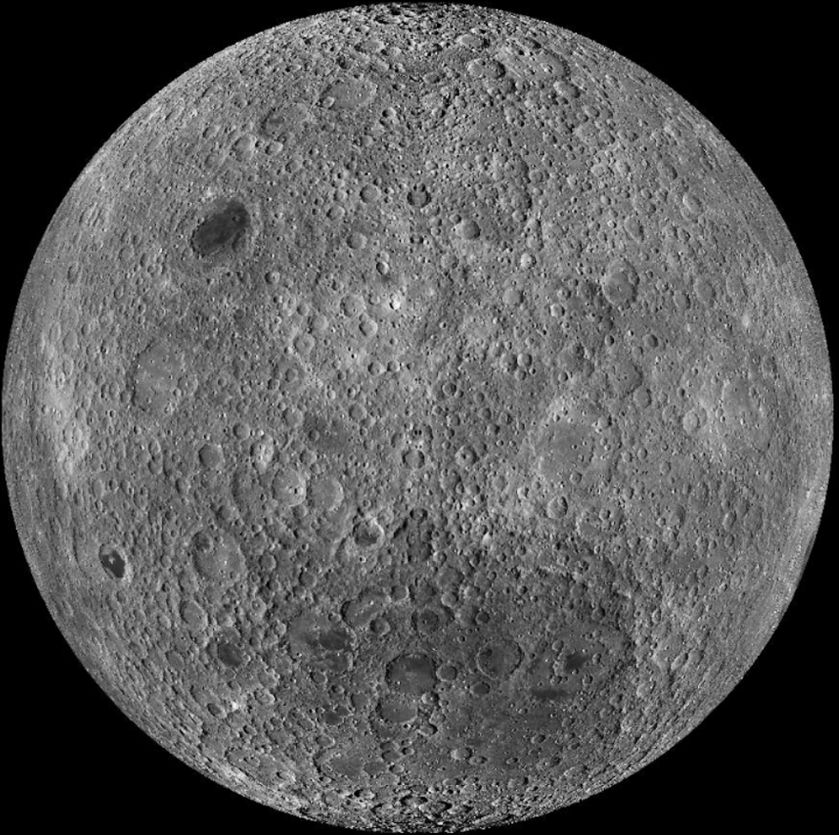Lunar Facts
- About 4.5 billion years ago, the Moon was probably formed after a collision between the premordial Earth and another perhaps Mars-sized protoplanet which has been named Theia. The debris from this "giant impact" gathered (accreted) in an initially low orbit around Earth to form the Moon in relatively short time. The so obliterated Theia is assumed to have formed near Earth explaining the similarity between lunar and terran rock.
- The mean orbital speed of the Moon is 3,680 kilometers per hour (2,287 mph) and is moving away from Earth at a rate of 38mm (1.5 inches) per year.
- The dark patches on the lunar surface are not oceans like on Earth but cooled down molten lava which surfaced after asteroid impacts and volcanic activities about 3.9 billions of years ago. In fact once they were seas, but seas of molten rock. The "mare" appear darker because of lower light reflectivity (albedo). In November 2020, NASA announced that it has confirmed water molecules, H2O, in sunlit areas of the Moon, indicating that water is widely distributed across the lunar surface though the Sahara Desert has 100 times the amount of water than what was detected by the SOFIA mission.
- Compared with the Earth, the Moon contains less iron and only few volatiles that evaporate easily, such as water and others, but it has more of aluminum and titanium (perhaps from the impactor), which are the cause of notable color hues on the lunar surface in contrast with lunar rock.
- In view of the large size of the Moon relative to Earth, the Earth-Moon system is often referred to as a double-planet. Since the center of gravity currently lies 1700 km inside Earth, it does not satisfy the definition of a double planet. The Moon is almost as wide as the Australian continent (4000km), of course not in terms of surface area.
- The Moon shows only one side because it rotates once around its axis while orbiting once around Earth (tidally locked). However, due to wobbling effects as a result of orbital inclinations not being zero (lunar libration) we can observe 59% (50% at a time) of its surface as it shifts in perspective.
- The temperature difference between a lunar day and night is 300ーC, i.e., +127°C during daytime and -173° during night time. The moon is exposed to 327.5 hours of sunlight and 327.5 hours of darkness during its orbital period of 27.3 days. Its gravity is 0.165 that of Earth.
- The Earth's axial tilt is 23.45° which results in our seasons. The Moon's tilt is 1.54° in that there are hardly any seasonal changes. There are regions which remain in permanent shadow, mostly crater floors at the south pole. This is where frozen water is assumed to occur in 'large' quantities.
- Due to ancient lava flows, there are large scale caves "pits", lava tubes and caves which entrances are called "skylights", or geological doorways to underground tunnels, wide enough to contain a city -- after filling with air and closing the entrance. Marius Hills, a region inside Oceanus Procellarum, is home to a series of lava tubes several kilometers long. Lava tubes have been found on both sides of the Moon.
- The far side of the Moon has no large dark Mare and is heavily cratered. The only exception is Mare Moscoviense in the northwest. This is because the surface of the far side is about 30km thicker in that asteroid impacts did not open the crust to allow lava to flow over the surface. After forming, the Moon was much closer to Earth and tidally locked with one side always facing the scorching hot premordial Earth which heated the lunar surface up keeping it volcanologically active and thin.
 Courtesy: NASA
Courtesy: NASA
 Crater Antoniadi, near the south pole on the far side, contains the lowest point on the Moon.
Crater Antoniadi, near the south pole on the far side, contains the lowest point on the Moon.Courtesy: NASA/USGS/LRO
 The lunar south pole (bottom right)
The lunar south pole (bottom right)Author's image
 An entrance (skylight) to a lava cave in Mare Ingenii on the rear side.
An entrance (skylight) to a lava cave in Mare Ingenii on the rear side.Courtesy: NASA/Goddard/Arizona State University
Near Side
 Courtesy: NASA/LROC
Courtesy: NASA/LROC
Far Side
 Courtesy: NASA/LROC
Courtesy: NASA/LROC

